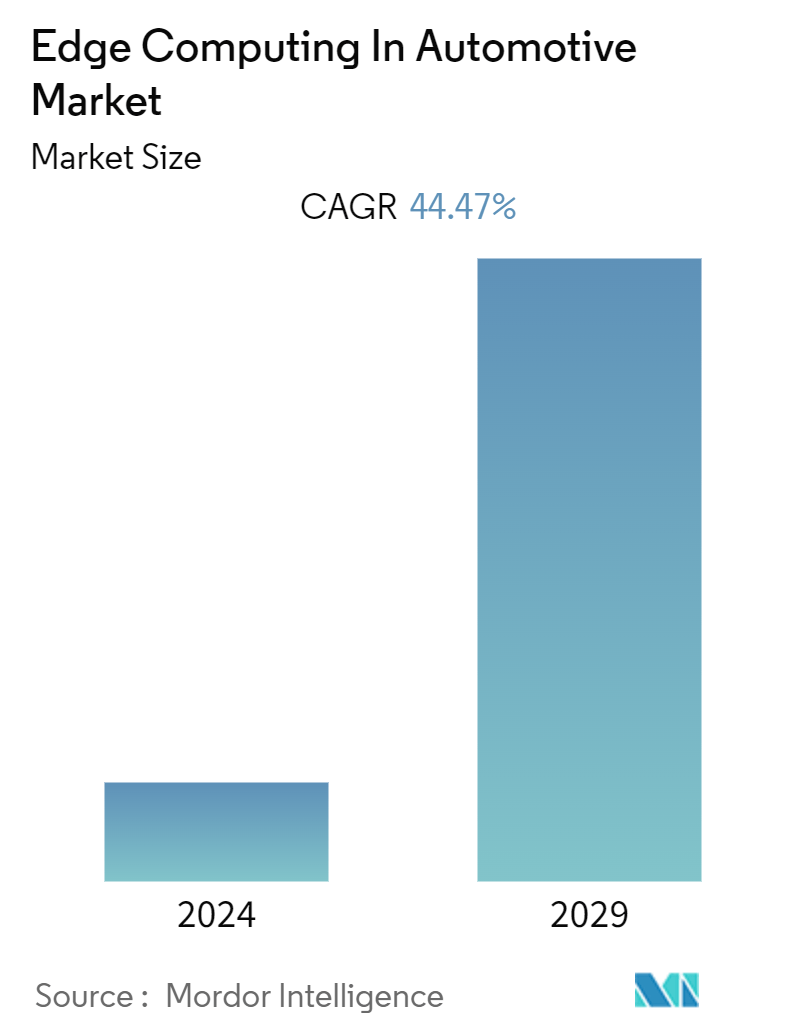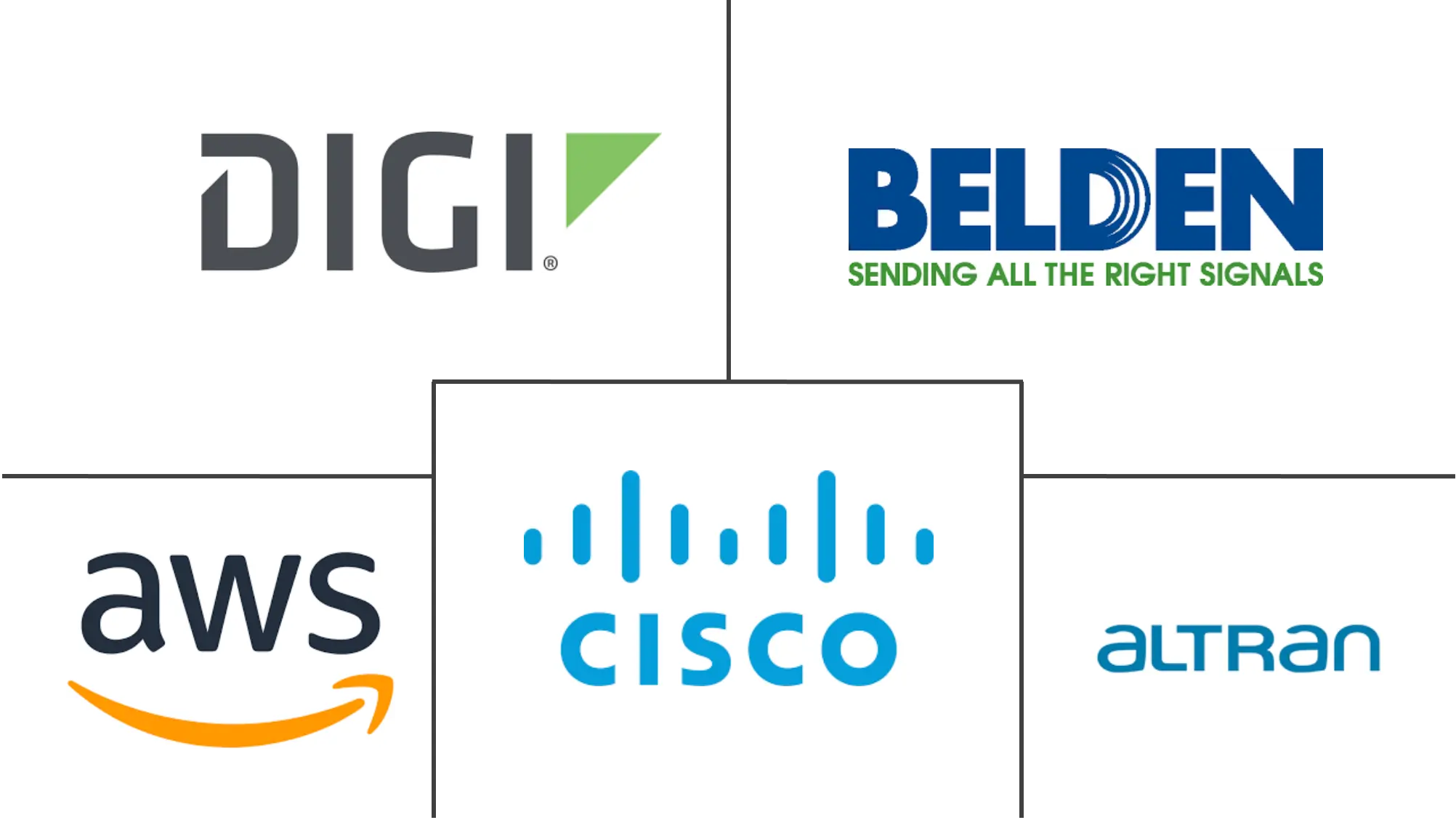Market Size of Edge Computing In Automotive Industry

| Study Period | 2019 - 2029 |
| Base Year For Estimation | 2023 |
| CAGR (2024 - 2029) | 44.47 % |
| Fastest Growing Market | Asia Pacific |
| Largest Market | North America |
| Market Concentration | Medium |
Major Players
*Disclaimer: Major Players sorted in no particular order |
Edge Computing In Automotive Market Analysis
The Edge Computing In Automotive Market is expected to register a CAGR of 44.47% during the forecast period.
The evolution of autonomous vehicles and connected car infrastructure and the requirement for lightweight frameworks and systems to heighten the efficiency of edge computing solutions are anticipated to generate abundant opportunities for edge computing vendors.
- Enterprises across automotive are beginning to drive new levels of performance and productivity by deploying different technological innovations, like sensors and other data-producing and collecting devices, along with analysis tools. Traditionally, data management and analysis are performed in the cloud or data centers. However, the scenario seems to be changing with the increasing penetration of network-related technologies and initiatives, such as smart manufacturing and smart cities.
- For connected cars to give the value they are expected to, there is a device that can concoct this data in real time. Edge computing is the method of processing data from IoT (Internet of Things) devices where it is generated. With the edge, the data being gathered gets examined right at the source.
- Moreover, processing increasing amounts of data at a faster pace, generated by industrial robots and connected cars equipped with various sensors, is problematic, and 5G applications are solving such issues with their low latency and high reliability, making it easier to offload part of this processing need to edge or cloud-based servers, thus, minimizing the complexity.
- Additionally, the absence of a "global" border and an ecosystem with a single owner that is governed by numerous individuals who must cooperate through networks makes it even more vulnerable. A piece of the infrastructure may be under the control of highly localized attacks with localized impact.
Edge Computing In Automotive Industry Segmentation
Edge computing concentrates on the data that is close to where it is generated. The term thus complements the term cloud computing, which relates to the computing power in data centers. Edge computing helps to restrict the amount of data that is bootlegged out in a smart way, which decreases the data transmission costs and also decreases the volume of raw and sensitive data leaving the vehicle.
edge computing in the automotive market is segmented into applications (connected cars, traffic management, smart cities, transportation & logistics) and geography (North America, Europe, and Asia-Pacific). The market sizes and forecasts are provided in terms of value in USD for all the above segments.
| By Application | |
| Connected Cars | |
| Traffic Management | |
| Smart Cities | |
| Transportation & Logistics | |
| Other Applications |
| By Geography*** | |
| North America | |
| Europe | |
| Asia | |
| Latin America | |
| Middle East and Africa |
Edge Computing In Automotive Market Size Summary
The automotive edge computing market is poised for significant growth, driven by the increasing integration of autonomous vehicles and connected car infrastructure. This evolution necessitates lightweight frameworks and systems to enhance the efficiency of edge computing solutions, presenting ample opportunities for vendors in this space. The shift from traditional cloud-based data management to edge computing is facilitated by advancements in IoT technologies, which allow for real-time data processing at the source. This transition is further supported by the deployment of 5G applications, which offer low latency and high reliability, enabling more efficient data handling for industrial robots and connected cars. The distributed nature of edge computing systems enhances resilience and productivity, making them a preferred choice over cloud-based designs.
North America currently holds the largest share of the automotive edge computing market, with expectations to maintain its dominance due to the region's reliance on IoT devices and higher cloud adoption. The development of autonomous vehicles and the presence of numerous edge computing suppliers contribute to the region's growth. The market is moderately competitive, with major players holding significant shares in developed nations, while developing countries like Japan and China see a more fragmented landscape. International companies are expanding their presence in these markets through mergers and acquisitions, recognizing the potential opportunities. Recent technological advancements and partnerships, such as those by Belden Inc., Digi International, and Cisco Systems, further underscore the dynamic nature of the market, as they introduce solutions to optimize connectivity and enhance network security in automotive applications.
Edge Computing In Automotive Market Size - Table of Contents
-
1. MARKET INSIGHTS
-
1.1 Market Overview
-
1.2 Value Chain / Supply Chain Analysis
-
1.3 Industry Attractiveness - Porter's Five Forces Analysis
-
1.3.1 Bargaining Power of Buyers/Consumers
-
1.3.2 Bargaining Power of Suppliers
-
1.3.3 Threat of New Entrants
-
1.3.4 Threat of Substitute Products
-
1.3.5 Intensity of Competitive Rivalry
-
-
-
2. MARKET SEGMENTATION
-
2.1 By Application
-
2.1.1 Connected Cars
-
2.1.2 Traffic Management
-
2.1.3 Smart Cities
-
2.1.4 Transportation & Logistics
-
2.1.5 Other Applications
-
-
2.2 By Geography***
-
2.2.1 North America
-
2.2.2 Europe
-
2.2.3 Asia
-
2.2.4 Latin America
-
2.2.5 Middle East and Africa
-
-
Edge Computing In Automotive Market Size FAQs
What is the current Edge Computing in Automotive Market size?
The Edge Computing in Automotive Market is projected to register a CAGR of 44.47% during the forecast period (2024-2029)
Who are the key players in Edge Computing in Automotive Market?
Aricent, Inc., Belden Inc., Digi International Inc., Cisco Systems, Inc. and Amazon Web Services (AWS), Inc. are the major companies operating in the Edge Computing in Automotive Market.

